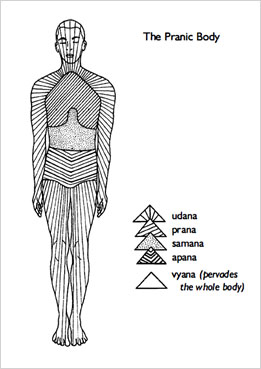Pranamaya kosha is made up of five major pranas, which are collectively known as the pancha, or five pranas: prana, apana, samana, udana and vyana.
Prana in this context does not refer to cosmic prana, but rather to just one flow of energy, governing the thoracic area between the larynx and the top of the diaphragm. It is associated with the heart and organs of respiration together with the muscles and nerves that activate them. It is the force by which the breath is drawn inside.
Apana governs the abdomen, below the navel region, and provides energy for the large intestine, kidneys, anus and genitals. It is concerned with the expulsion of waste from the body and is the force which expels the breath.
Samana is located between the heart and the navel. It activates and controls the digestive system: the liver, intestines, pancreas and stomach, and their secretions. Samana is responsible for transformation. On a physical level this relates to the assimilation and distribution of nutrients. On an evolutionary level it relates to kundalini and expansion of consciousness.
Udana governs the neck and head, activating all the sensory receptors such as the eyes, tongue, nose and ears. U dana also harmonizes and activates the limbs and all their associated muscles, ligaments, nerves and joints. It is responsible for the erect posture of the body, sensory awareness, and the ability to respond to the outside world.
Vyana pervades the whole body, regulating and controlling all movement, and coordinating the other pranas. It acts as the reserve force for the other pranas.
Along with these five major pranas there are five minor pranas known as the upa-pranas: naga, koorma, krikara, devadatta and dhananjaya. Naga is responsible for belching and hiccups. Koorma opens the eyes and stimulates blinking. Krikara generates hunger, thirst, sneezing and coughing. Devadatta induces sleep and yawning. Dhananjaya lingers after death and upon its departure, decay and decomposition of the body begins to happen.
